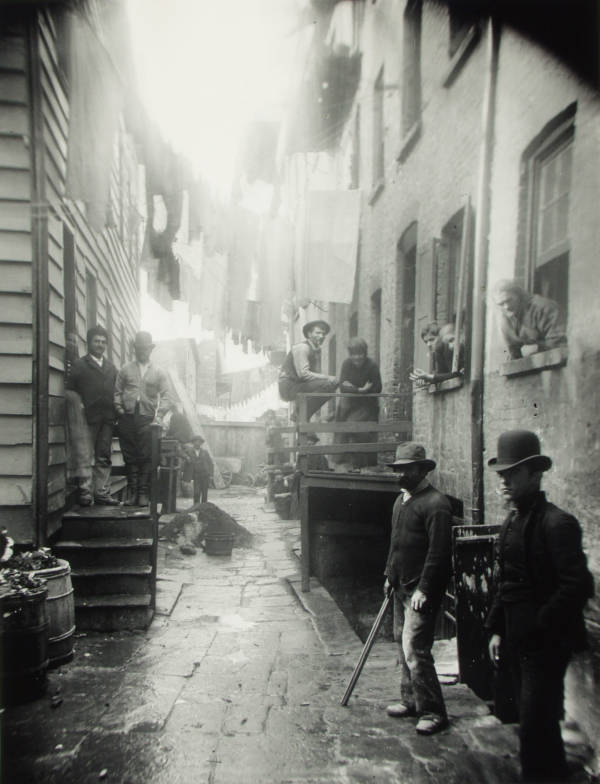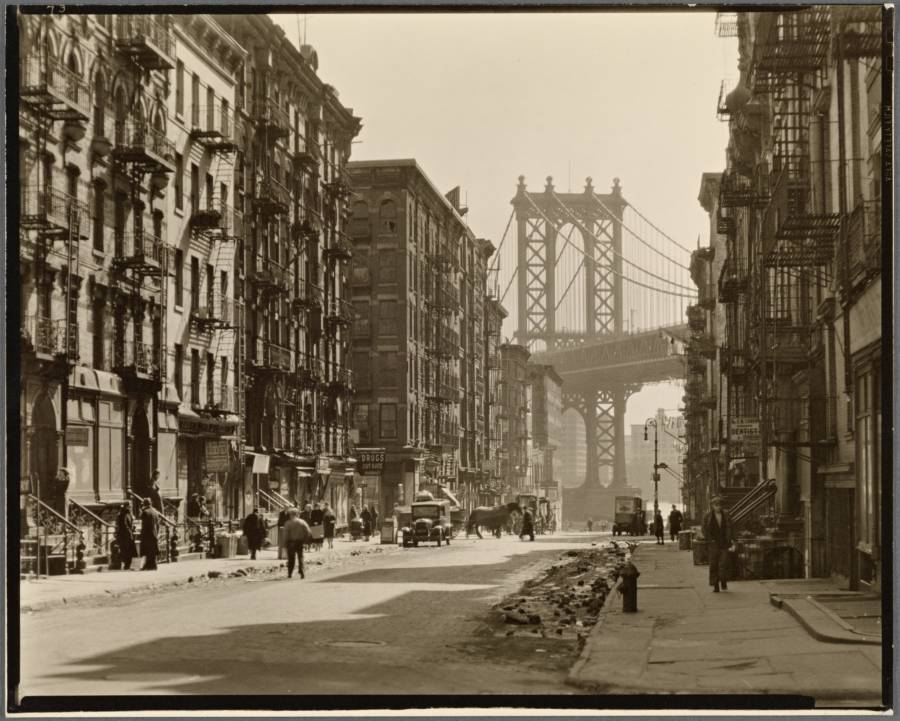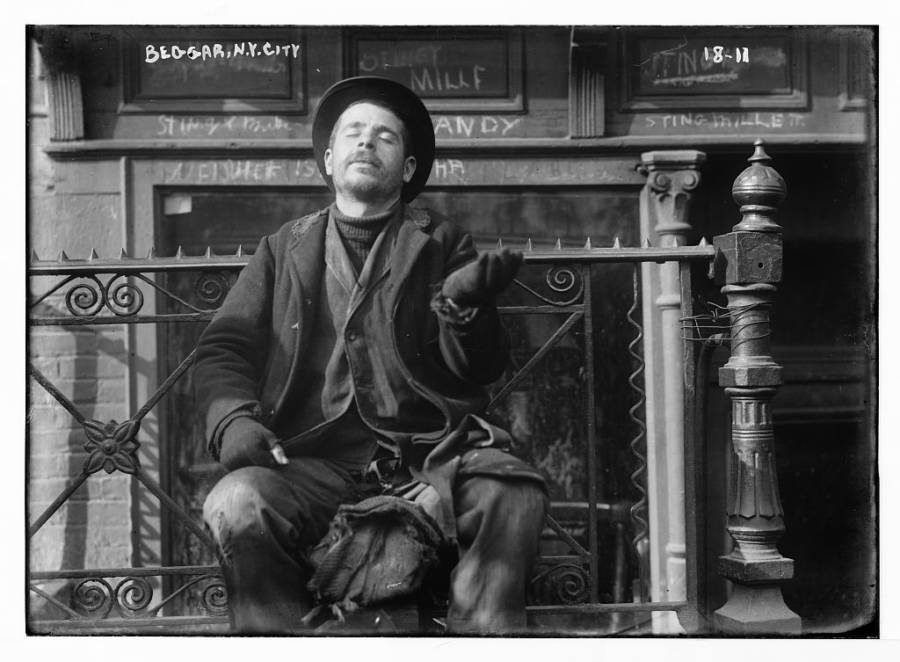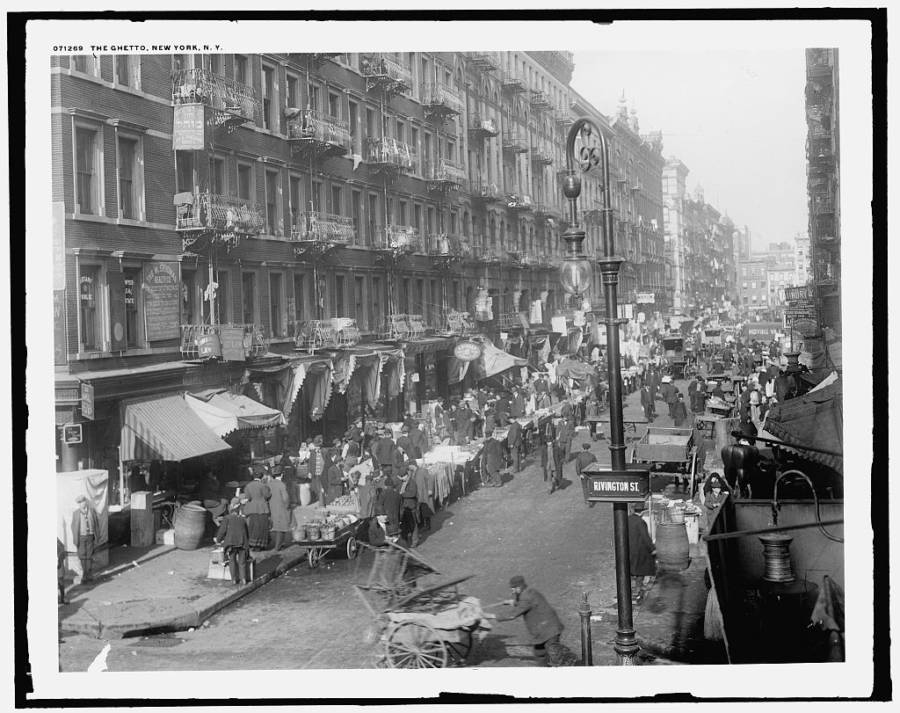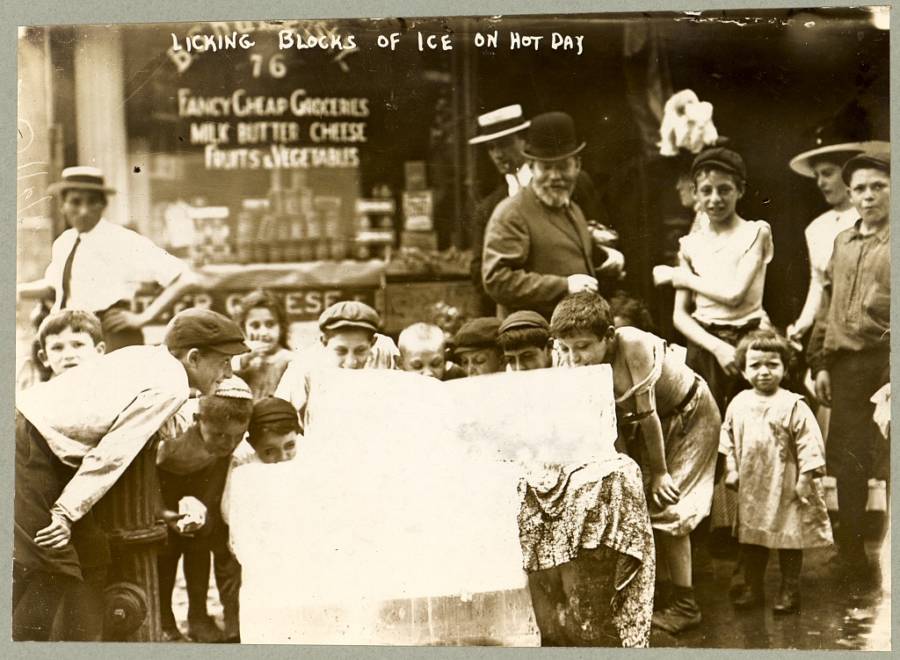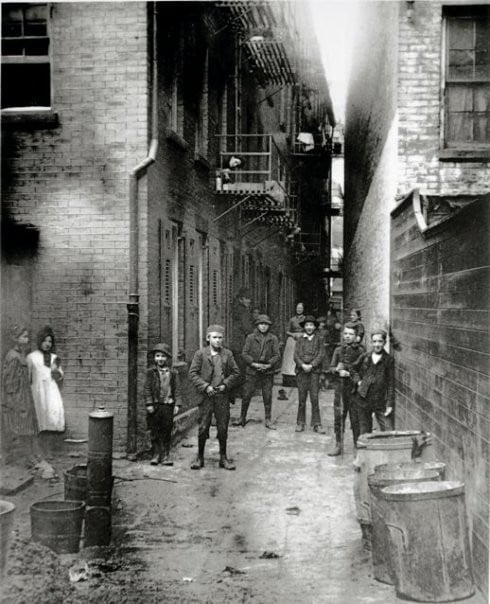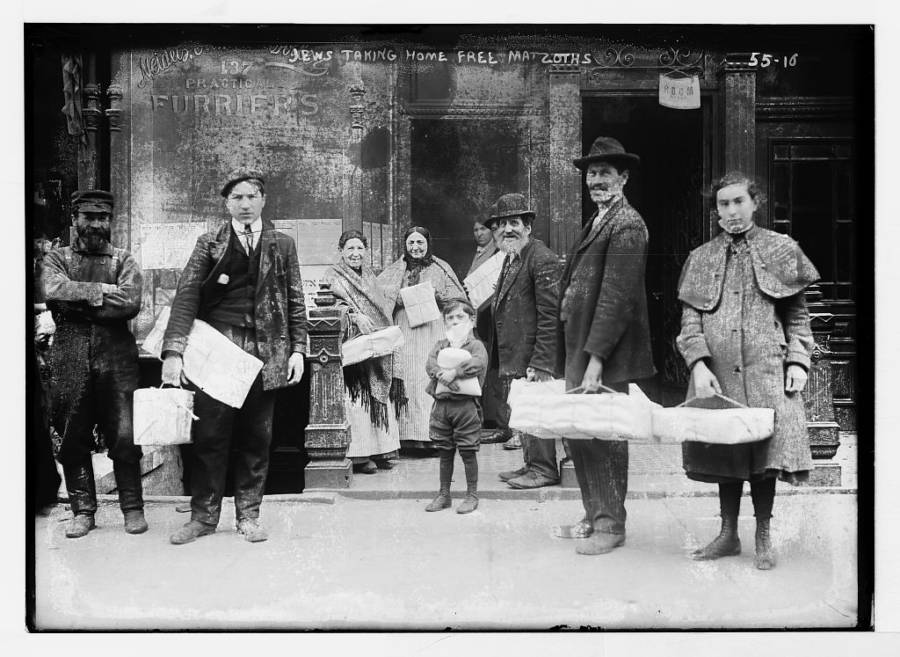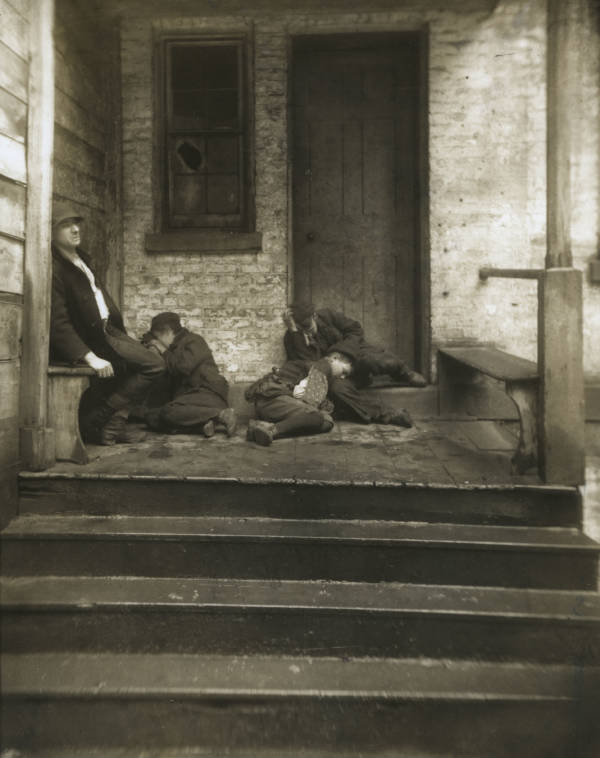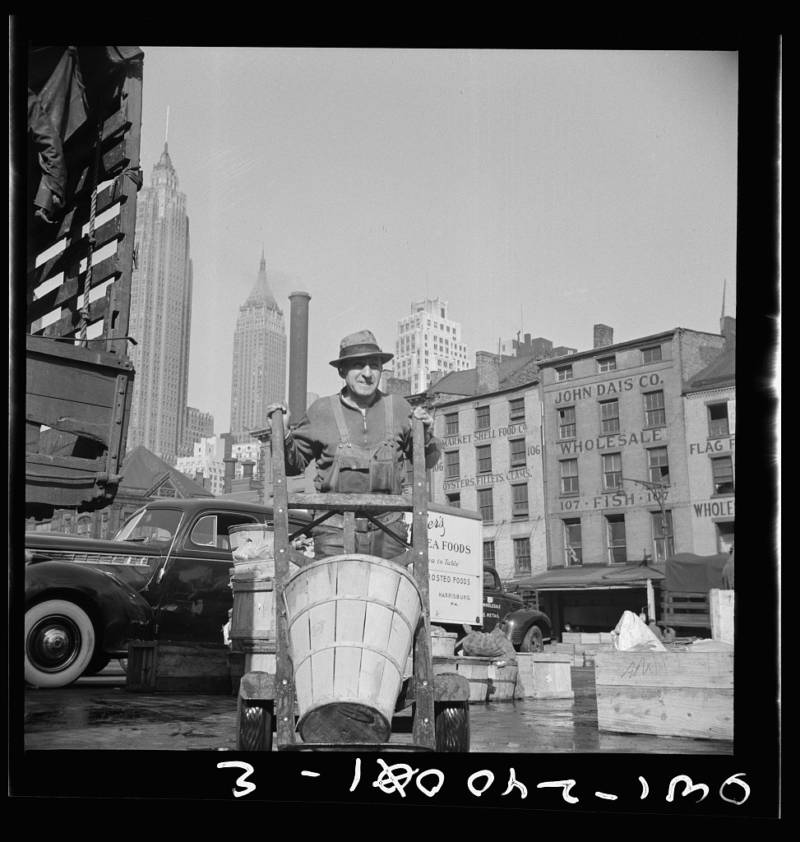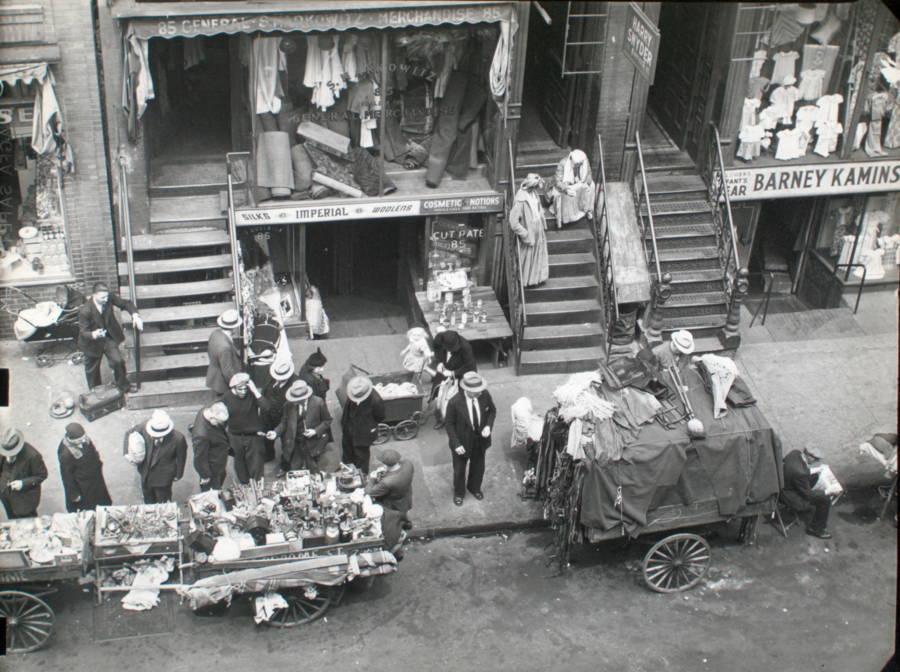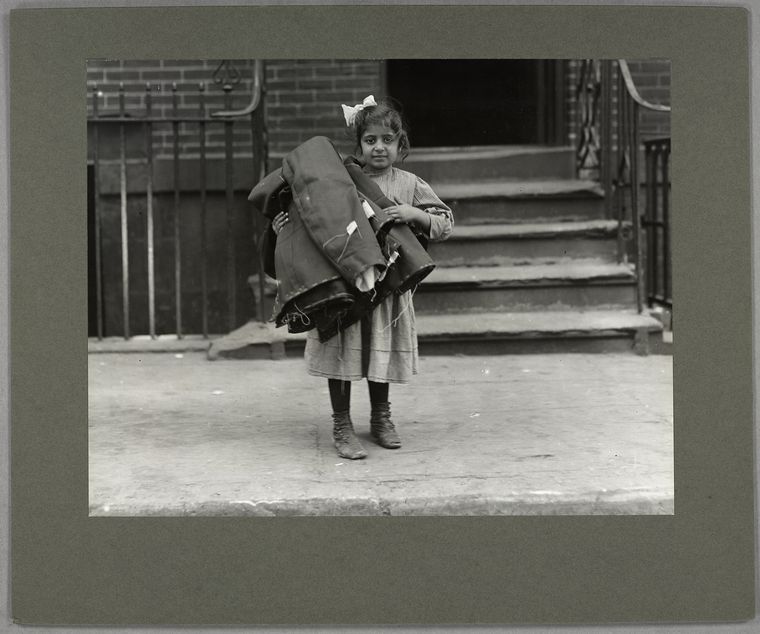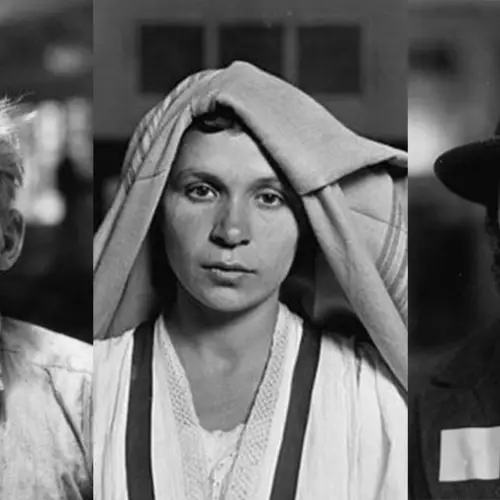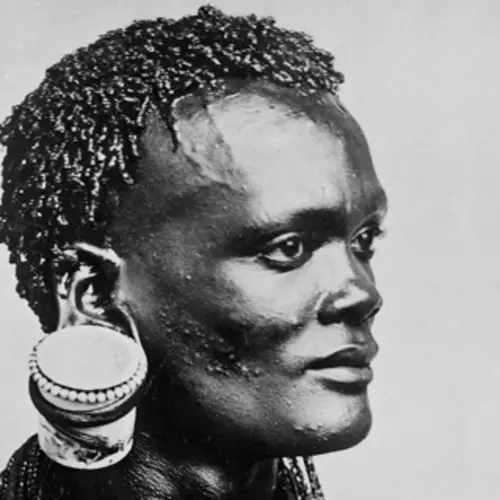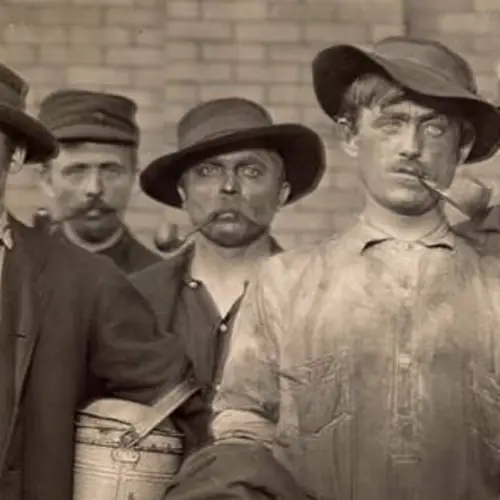1 of 52
"Bandit's Roost," a notorious hangout for the criminal element at 59 Mulberry Street in Little Italy, 1888. At the time, the area was among the most impoverished and crime-ridden in the entire city.
This image comes from photographer and journalist Jacob Riis' 1890 work How The Other Half Lives, which helped reveal the blight among New York's immigrant neighborhoods.Jacob Riis/Wikimedia Commons
2 of 52
Pike and Henry Streets in the Lower East Side, with the Manhattan Bridge looming in the background, 1936.Berenice Abbott/New York Public Library
3 of 52
Beggar with his hand out (undated photo, circa 1900-1920).Bain News Service/Library of Congress
4 of 52
Rivington Street in the Lower East Side, circa 1900-1915.Detroit Publishing Co./Library of Congress
5 of 52
Children lick a massive block of ice to stay cool on July 6, 1912.Library of Congress
6 of 52
An Italian immigrant carries a dry goods box down Bleecker Street, February 1912.Lewis Wickes Hine/Library of Congress
7 of 52
A beggar, perhaps disfigured during World War I, sits on the street (undated photo, early 1900s).Bain News Service/Library of Congress
8 of 52
Street children sleeping, circa 1890.Jacob Riis/Wikimedia Commons
9 of 52
An Italian immigrant's shop on Mott Street circa 1912.Library of Congress
10 of 52
Refuse piles up at the entrance to the tenements at 53 to 59 MacDougal Street, February 1912.
In the late 1800s and early 1900s, New York City's trash problem reached epic proportions. In 1894, newly elected mayor William Strong knew he had to do something, and offered the job of sanitation commissioner to Teddy Roosevelt, who refused, essentially saying that it was an impossible job.Lewis Wickes Hine/Library of Congress
11 of 52
Things got even worse during the garbage strike of November 8-11, 1908. Pictured: Crowds and police gather in the street during the strike.Bain News Service/Library of Congress
12 of 52
The "White Wings" clean the streets, under police protection, during the garbage strike of November 8-11, 1908.
The "White Wings" took to the streets under the orders of pioneering sanitary engineer George Waring, whose efforts ameliorated but didn't totally solve the city's trash problem.Library of Congress
13 of 52
Children play near a dead horse left to rot in the street, circa 1905.Wikimedia Commons
14 of 52
Children gather in Mullen's Alley in the Cherry Hill area of lower Manhattan, 1888.Jacob Riis/Wikimedia Commons
15 of 52
A woman carries a bundle of clothing to be sewn at home near Astor Place, February 1912.
Poor immigrant workers often toiled for long hours and took their work home with them.Lewis Wickes Hine/Library of Congress
16 of 52
A street peddler who'd slept in a basement at 11 Ludlow Street in the Lower East Side, 1899.Jacob Riis/Wikimedia Commons
17 of 52
Two women and a man gather in front of outhouses at an unspecified location, circa 1902-1914.
Most turn-of-the-century New York City tenements didn't have indoor plumbing.New York Tenement House Department/New York Public Library
18 of 52
A food vendor sells his wares in the streets of the Lower East Side on February 24, 1917.Bain News Service/Library of Congress
19 of 52
Dead bodies lie in an alley off Monroe Street following a nearby fire, December 1913.Library of Congress
20 of 52
Men wait on the bread line in the Bowery on February 7, 1910.Library of Congress
21 of 52
Jewish immigrants carry packages of matzo, April 1908.Bain News Service/Library of Congress
22 of 52
The Municipal Lodging House for the homeless sits across the street from an abandoned lot on 25th Street, circa 1909-1920.
The house opened in February 1909 to help treat a citywide homelessness problem that saw as many as 600 new applicants looking for shelter each day.Library of Congress
23 of 52
Men stand at a corner on Chinatown's Pell Street, circa 1900.Byron/Library of Congress
24 of 52
Crowds at Pitt and Rivington Streets in the Lower East Side, 1915.Underwood & Underwood/Library of Congress
25 of 52
Street festival in Little Italy, 1908.Library of Congress
26 of 52
Clothes line the railings of the tenements at 260 to 268 Elizabeth Street, March 1912.Lewis Wickes Hine/Library of Congress
27 of 52
Street dweller, circa 1890.Jacob Riis/Wikimedia Commons
28 of 52
Children wearing signs in English and Yiddish protest child labor conditions on May 1, 1909.
At the turn of the century, just about one-fifth of America's workforce was under the age of 16 -- and New York was no exception.Library of Congress
29 of 52
Boys in Hell's Kitchen demonstrate how they rob people who have passed out. Jacob Riis/Wikimedia Commons
30 of 52
Children behind the tenements at 134 1/2 Thompson Street, February 1912.Lewis Wickes Hine/Library of Congress
31 of 52
Two newspaper boys asleep in the press room of The Sun, 1892.
Working for the newspapers was one dependable way for young boys to earn some extra money for their families. However, their labor was often exploited and undervalued, leading to the infamous newsboys strike of 1899.Jacob Riis/Wikimedia Commons
32 of 52
Chinatown storefront, circa 1903.Library of Congress
33 of 52
Man killed by a bomb at an anarchist rally in Union Square on March 28, 1908.
In the face of a depressed economic climate and exploitative labor conditions, among other far-reaching factors, anarchism saw a wave of popularity in the U.S. in the late 1800s and early 1900s, with New York being no exception. Library of Congress
34 of 52
107th Street just east of 3rd Avenue, February 1912.Lewis Wickes Hine/Library of Congress
35 of 52
Street merchants in Little Italy (undated photo, most likely circa 1900-1920).Bain News Service/Library of Congress
36 of 52
Children prepare to transport a load of kimonos on Thompson Street, February 1912.Lewis Wickes Hine/Library of Congress
37 of 52
Hell's Kitchen, just before 1890.Jacob Riis/Wikimedia Commons
38 of 52
Impoverished populations in the Lower East Side, circa late 1800s.Jacob Riis/Wikimedia Commons
39 of 52
Little Italy's Mulberry Street, circa 1890.Jacob Riis/Wikimedia Commons
40 of 52
The Bowery, February 1912.
The Bowery, a street and eponymous neighborhood running through what is now Manhattan's East Village, was a notorious hotbed of crime, poverty, and taboo behaviors (prostitution and homosexuality among them) during the wave of immigration to New York City in the late 1800s and early 1900s.Lewis Wickes Hine/Library of Congress
41 of 52
21-23 Pearl Street (undated photo, circa 1890-1919).Robert L. Bracklow Photograph Collection/New York Historical Society
42 of 52
Stevedore working in the fish market of the Lower East Side, May-June 1943.Gordon Parks/Library of Congress
43 of 52
A boy uses the curbside water pump at Trinity Place, just south of Cedar Street, 1902.
Public pumps like these allowed poorer people who didn't have their own taps access to running water.Robert L. Bracklow Photograph Collection/New York Historical Society
44 of 52
Street peddler in the Lower East Side (undated photo, circa late 1800s to early 1900s).New York Public Library
45 of 52
Hester Street, between Allen and Orchard Streets in the Lower East Side, 1938.Berenice Abbott/New York Public Library
46 of 52
A girl on the sidewalk in Little Italy, circa 1950s.Walter Silver American/New York Public Library
47 of 52
Orchard Street in the Lower East Side, circa 1902-1914.New York Tenement House Department/New York Public Library
48 of 52
Ten-year-old child waits to walk across Broadway at Leroy Street, February 1912.Lewis Wickes Hine/Library of Congress
49 of 52
Rooftop pigeon coop at an unspecified location, circa 1934-1938.New York Tenement House Department/New York Public Library
50 of 52
A young girl brings cloth "homework" back to her tenement to be sewn, circa 1912.Lewis Wickes Hine/New York Public Library
51 of 52
Mulberry and Prince Streets, 1935.Berenice Abbott/New York Public Library
52 of 52
Like this gallery?
Share it:
